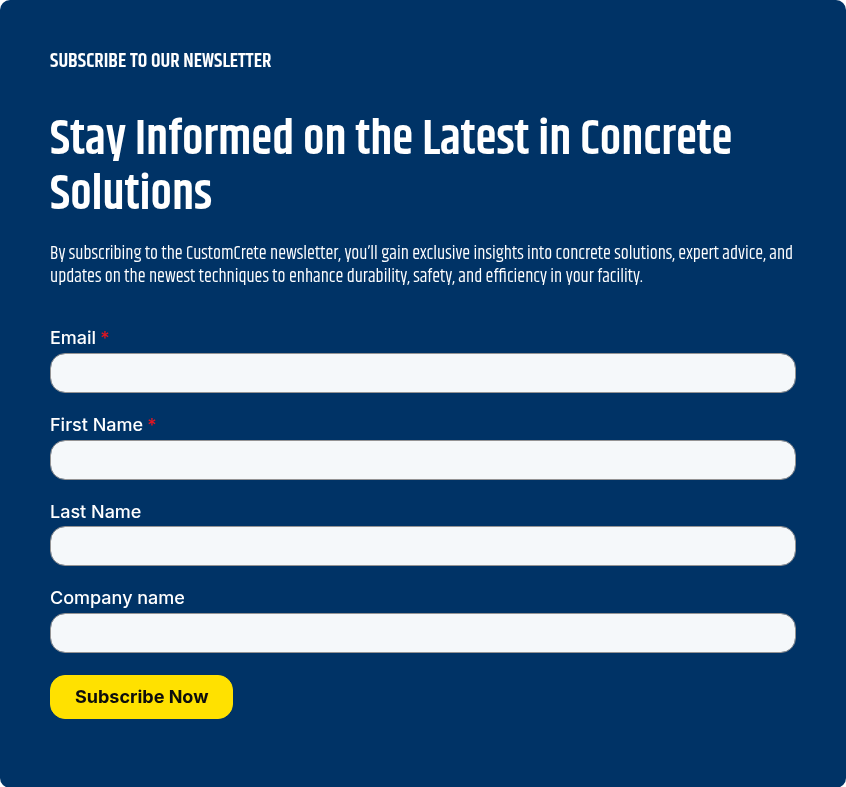
Concrete is known for its strength and resilience, but when left unprotected, even the toughest concrete surfaces can wear down over time. That’s where a concrete sealer comes in. It protects the surface, enhances durability, and helps the floor resist moisture, chemicals, stains, and abrasions.
But how long does sealed concrete actually last? And what factors affect its performance over time?
At CustomCrete, we work with businesses throughout the Chicago area to install and maintain sealed concrete flooring systems that are built to last. In this blog, we’ll break down how long sealed concrete typically lasts, what impacts its longevity, and how to care for it properly.
Average Lifespan of Sealed Concrete
A professionally sealed concrete surface can last anywhere from 3 to 10 years or more, depending on the type of sealer used, the environment it’s in, and how well it’s maintained.
Here's a general guide:
- Acrylic Sealers: 1–3 years (ideal for indoor spaces or decorative finishes)
- Penetrating Sealers: 5–10 years (used in industrial and exterior environments)
- Epoxy or Urethane Sealers: 5–10+ years (heavy-duty, chemical-resistant applications)
Regular maintenance and reapplication can extend the lifespan and performance of your sealed surface well beyond the initial years.
Key Factors That Affect Longevity
Several important elements influence how long your sealed concrete will last. Understanding these variables can help you make informed choices about products, installation, and maintenance.
1. Type of Concrete Sealer
Not all sealers are created equal. Acrylic sealers are cost-effective but wear down faster. Penetrating sealers bond below the surface and provide longer-lasting protection. Epoxy and urethane coatings offer maximum durability but require more prep and investment.
2. Surface Usage and Traffic
The more wear and tear a surface sees, the faster the sealer will break down. High-traffic industrial areas or commercial floors with forklifts, carts, or heavy foot traffic will need more frequent reapplications compared to light-use spaces.
3. Environmental Exposure
UV exposure, moisture, temperature swings, and chemicals all impact how long a sealer lasts. Outdoor sealed concrete exposed to freeze-thaw cycles or de-icing salts may degrade faster than interior sealed floors.
4. Application Quality
Proper surface preparation, correct application methods, and using the right product for your space are essential. A poorly applied sealer will wear out prematurely, regardless of the product type.
5. Maintenance Practices
How you clean and care for the surface also matters. Using harsh chemicals, abrasive tools, or failing to remove debris can shorten the life of the seal. On the other hand, routine dust mopping and neutral cleaners can help the sealer last longer.
Signs Your Sealed Concrete Needs Recoating
Even the best sealers eventually wear out. Here are common signs it’s time for reapplication:
- Dull or faded appearance
- Increased staining or discoloration
- Surface feels rougher or more porous
- Water no longer beads on the surface
- Cracks, chips, or abrasions in the coating
- Difficulty cleaning
Catching these early helps you avoid costly damage and prolong the integrity of your flooring.
Best Practices to Extend the Life of Sealed Concrete
Following a few key habits can go a long way toward preserving the protective qualities of your concrete sealer and maximizing its lifespan.
1. Use the Right Cleaning Products
Avoid bleach, vinegar, or ammonia-based cleaners that can strip the sealer. Stick to pH-neutral solutions made specifically for sealed surfaces.
2. Protect High-Traffic Areas
Use mats, runners, or designated pathways in high-use zones to reduce wear and tear.
3. Address Spills Quickly
Even with a sealer, long exposure to chemicals, oils, or food waste can leave stains or cause breakdowns. Clean up spills promptly.
4. Schedule Regular Inspections
Having your floor assessed annually by a concrete professional can help identify early signs of wear and determine if spot repair or full resealing is needed.
5. Reapply on Schedule
Don’t wait for the sealer to fully break down. Reapplying on a proactive schedule—typically every 3–5 years for most commercial spaces—ensures continuous protection.
Is Sealed Concrete a Good Long-Term Investment?
Yes—especially when it’s matched to the right environment and maintained properly. Sealed concrete offers excellent value by:
- Reducing the need for constant deep cleaning
- Enhancing safety through slip resistance and smoother finishes
- Preventing moisture intrusion and surface damage
- Increasing the overall lifespan of your concrete slab
Whether you’re managing a warehouse, office, production facility, or retail space, a quality concrete sealer can keep your floors looking good and performing well for years.
Final Thoughts
The longevity of sealed concrete depends on a mix of product choice, usage, and care. But with the right system in place—and a proactive maintenance plan—you can expect your sealed floor to hold up for 5 to 10 years or more before needing a full recoat.
At CustomCrete, we help businesses across Chicago choose the right sealers and maintenance routines to maximize performance and lifespan.
Need help budgeting the right sealer or reapplying an old one? Visit our next blog on “Cost of Concrete Sealing for Factories in Chicago”.

Topics:















.jpeg?width=360&height=253&name=IMG_0701%20(1).jpeg)






